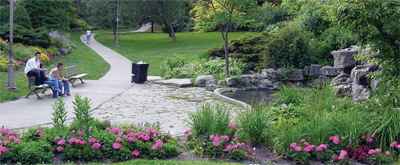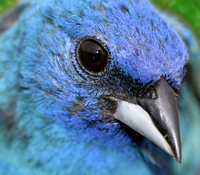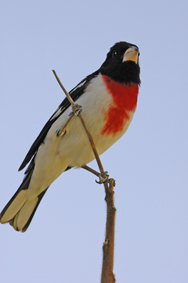The Beaches Living Guide will conduct a guided walking tour in the Glen Stewart
Ravine.
 Join
Max Skwarna for a two hour adventure to explore the birds, animals, and natural
areas. Birders and photographers all welcome! Binoculars if you plan to bird
watch.
Join
Max Skwarna for a two hour adventure to explore the birds, animals, and natural
areas. Birders and photographers all welcome! Binoculars if you plan to bird
watch.
Glen Stewart Ravine Bird Watching with Max
TIME: Sunday, April 23th, 2006, 9 am
(New dates will be posted soon)
MEET: Queen & Glen Manor Dr.
INFO: info@beachesliving.ca
OR CALL: 416-690-4269
 Experience
nature's charms in Glen Stewart ravine
Experience
nature's charms in Glen Stewart ravine
It's a lovely place to walk in any season. During April and May there is an added attraction: large numbers of colourful songbirds rest in the ravine before heading to their nesting sites farther north.
Around the end of April and through May it's not unusual to see 40 to 50 species of songbirds in an hour, says Fred Bodsworth, naturalist, long-time Beaches resident, and author of five books, including the classic The Last of the Curlews. [pic. with a group of birds]
 "Many
birds fly at night and feed during the day. You can see them on radar crossing
Lake Ontario," Fred explains. "At dawn, they have been flying maybe
10 hours and they need to refuel. They head for the closest green islands
that will provide them with food and shelter."
"Many
birds fly at night and feed during the day. You can see them on radar crossing
Lake Ontario," Fred explains. "At dawn, they have been flying maybe
10 hours and they need to refuel. They head for the closest green islands
that will provide them with food and shelter."
Warblers: Butterflies of the bird world
 The
Glen Stewart Ravine is a favourite spot for warblers from mid-April through
May.
The
Glen Stewart Ravine is a favourite spot for warblers from mid-April through
May.
These lovely little birds in their colourful spring plumage flit from branch
to branch in search of insects. No wonder they have been called the butterflies
of the bird world. The males sing almost constantly to attract mates and keep
other males away.
Some warblers to watch for:
- Black and White
- Black-throated Blue
- Black-throated Green
- Yellow
- Yellow-throated
- American Redstart
- Ovenbird
 If
you're lucky, you may glimpse the rare Cerulean Warbler or Hooded Warbler.
If
you're lucky, you may glimpse the rare Cerulean Warbler or Hooded Warbler.
From mid-May to mid-June, you're likely to see vireos in the ravine, particularly the Warbling and Red-eyed vireos. These small birds, olive coloured on their backs, are easily confused with warblers, but they are less active. The male sings constantly during spring and summer.
 The
Rose-breasted Grosbeak is so beautiful and its song so lovely that it is sold
as a caged bird in Central America where it winters. Fortunately this trade
is banned in North America. Look for this bird May through September in bushes,
shrubs and among small trees. Unlike most songbirds, the male sits on the
eggs almost as much as the female. After the eggs hatch he also helps brood
the young, keeps the nest clean and teaches the fledglings how to open seeds.
The
Rose-breasted Grosbeak is so beautiful and its song so lovely that it is sold
as a caged bird in Central America where it winters. Fortunately this trade
is banned in North America. Look for this bird May through September in bushes,
shrubs and among small trees. Unlike most songbirds, the male sits on the
eggs almost as much as the female. After the eggs hatch he also helps brood
the young, keeps the nest clean and teaches the fledglings how to open seeds.
The Scarlet Tanager is seldom seen except during migration in May and September. The males molt (replace their feathers) in March and April, returning in spring as brilliant scarlet birds with black wings. They molt again in late summer, becoming green like the females. Look for them at the edges of the woods and in oak trees where they feed on caterpillars and other insects.
The Indigo Bunting is another colourful bird - at least the male is with its rich deep blue plumage, becoming more of a brownish colour in fall, like the female. It is a common sight from mid-May to mid-July. Look for this bird in bushy wood edges.
Thrushes, a family of birds known for their fine singers (think of the robin), are familiar visitors to the Glen Stewart Ravine in the springtime and fall. The Hermit Thrush can be seen March to mid-April and mid-September to October; the Swainson's Thrush in May and September, and the Veery, less frequently in May and September.
The Wood Thrush, a fairly common sight May to mid-June, has one of the most elaborate and beautiful songs of all the songbirds (females as well as males). Watch for this plump, speckle-breasted, large-eyed bird on the forest floor searching for insects among the mushrooms and ferns.
Most of these birds will not stay in the ravine in summer. After resting and refueling, they will be off to forests farther north where they will build their nests and raise their young.
Summer and year-round residents
Some birds nest in the Glen Stewart Ravine and migrate in the fall; other birds manage to find enough food to stay year-round. The Cardinal is one fairly common resident. Blackcapped Chickadees, White-breasted Nuthatches, Blue Jays, and Downy Woodpeckers also make the ravine their full-time home.
Summer-only residents include Gray Catbirds, Common Flickers, Indigo Buntings, Yellow-bellied Sapsuckers, and the rarer Red-headed Woodpecker. The Yellow-bellied Sapsucker is a type of woodpecker. On some trees in the ravine you can see orderly rows of small holes drilled by sapsuckers to get at the sap. Other birds also drink the sap and eat the insects that get caught in it.
How to get to the Glen Stewart Ravine:
You can get into the ravine from Glen Manor Drive East, Balsam Avenue, or Beech Avenue, or take the stairway into the ravine from Kingston Road. The ravine has a trail running through it, which takes about 20 minutes to walk.
Other good places to see migrating songbirds in Toronto:
- Leslie Street Spit (Tommy Thompson Park)
- High Park
- Toronto Islands
For more information:
Canadian Songbirds and their ways, Trudy and Jim Rising
A Bird-Finding Guide to Ontario, Clive E. Goodwin
A Birdfinding Guide to the Toronto Region, Clive E. Goodwin
Eastern Birds, Roger Tory Peterson
Master Guide to Warblers of Canada, Canada's Digital Collections,
Royal Alberta Museum. View online at www.royalalbertamuseum.ca
The best way to learn about birds is to go out with experienced birders. The
Toronto Field Naturalists at www.sources.com/tfn and the Ontario Field Ornithologists
www.ofo.ca lead bird watching walks at various locations in the GTA.
Best times to see migrating songbirds in Glen Stewart Ravine
Hermit Thrush :: March to mid-April mid-September to October
Warblers (7-10 species):: mid-April through May
Wood Thrush :: May to mid-June
Rose-breasted Grosbeak :: May-September
Scarlet Tanager:: May and September
Swainson's Thrush:: May and September
Veery :: May and September
Warbling Vireo :: mid-May to mid-June
Red-eyed Vireo :: mid-May to mid-June
Indigo Bunting:: mid-May to mid-July
Please send your comments about our featured articles to info@beachesliving.ca. Also let us know what subject would you like to see in our future issues.